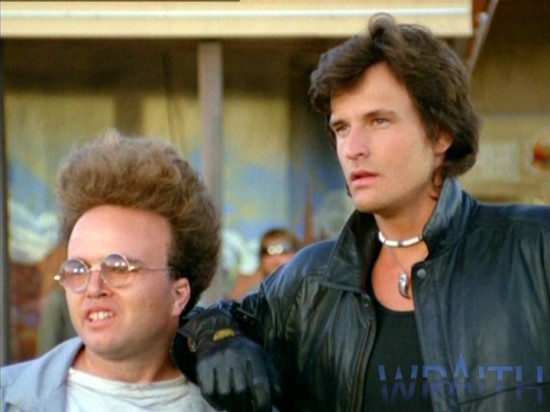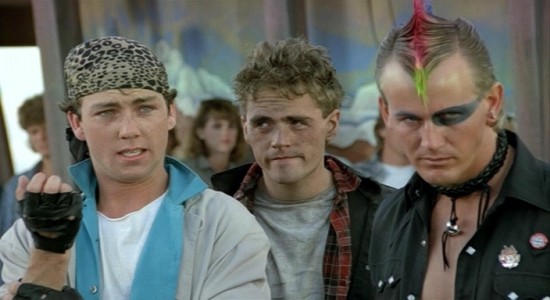Weekend Weirdness: The Wraith Special Edition DVD Explores The Cult Status And Troubled Production Of The (Oddly Lynchian?) '80s Film
It's a crazy, mixed up world and we are thankful for movies, excluding Valentine's Day starring every safe, boring white actor ever, that offer proof. Slashfilm's Weekend Weirdness examines such flicks, whether in the form of a new trailer for a provocative indie, a mini review or an interview.
In 1986, a supernatural moto-fantasy about a murdered bro who returns via a phantasmic, black stealth race car to kill his killers was released on Earth and no one gave a s***. More than two decades later, The Wraith, though forever without a wet 'stache lick from Peter Travers, is cult-minted for being memorable-enough '80s-ploitation. Next month sees the release of a Special Edition DVD that adequately recognizes and explores the movie's legacy and history with commentary courtesy director Mike Marvin and featurettes on the film's semi-iconic Dodge racer and co-star Clint Howard (who, if not semi-iconic himself, sported a semi-iconic wig inspired by Eraserhead for the film).
Revisiting The Wraith, what's interesting is how this derivative hybrid of genres and classic revenge films—Marvin references High Plains Drifter and The Road Warrior—remains sublimely adolescent but in an inherently cold and detached way. Stranger still is how this suits the film's undead hero, vehicle, and hints of an afterlife with a decidedly mechanical bent. And before viewing the S.E. I had no idea a crew member died and many others were injured in a chase scene gone awry. One stunt coordinator recounts how a grip fell 60-feet down a rocky embankment and was only found knocked-out but okay hours later. Nor did I know (or need to) that a sunbathing scene with lead star Charlie Sheen as the titular, ghostly hero and co-star Sherilyn Fenn (Twin Peaks, Wild at Heart) was shot on a "near-freezing" day. Hearing these stories, I wonder now if the troubles of the production didn't contribute to the overall tone. And looking back at the film itself, which was released the same year as Top Gun, Ferris Bueller, and Blue Velvet, might The Wraith, however unintentionally, deserve to be called Lynchian?

There are the obvious and literal connections and references to David Lynch noted above: Sherilyn Fenn's later involvement on Lynch productions and Howard's 'do (above), which is confirmed on the DVD to be directly inspired by Lynch's debut. One imperfection about the film I recall noticing when I first saw it on pay-cable pertains to flashback scenes where Charlie Sheen's character—pre-Wraith incarnation—is beaten and slain by a guy (Nick Cassavetes) who barges in during his bang session with Flynn. These scenes are strange because Sheen is not playing the character here—it's an actor who resembles Sheen but is clearly not his match, made apparent by several avoidable (poorly edited?) close-ups. Director Mike Marvin says on the commentary that these scenes were filmed late in the troubled production, after Sheen had already left to star in Oliver Stone's Platoon.
Marvin could be covering his ass when he explains that he actually preferred—but didn't plan per se—to film another actor in these scenes thereby making The Wraith's mysterious arrival into town in "Sheen form" more dubious to Cassavetes's character and his complicit gang of misfits.

Unfortunately, only with repeat viewings does this meta-interpretation sink in, likely problematic for the hormonal demographic the film was originally marketed to. Many many of these viewers, now fully grown into jaded adults, would note that when The Wraith appears on screen to death-race or unleash bloodshed with a futuristic, customized shotgun, he is clad in an extensive tech-body suit and tinted racing helmet (pictured above); re: there's no reason why Sheen, the infamously labor-savvy star he was and is, would really need to be on set for these scenes. So it goes that Sheen's human stand-in, if noticed, would further confirm suspicions of a small budget and rushed schedule—not the idea of a Lynchian doppleganger endorsed by Marvin and diehard fans.

But on closer inspection and lending credit to Marvin's vision, the character who was murdered was named Jamie, and upon return Sheen's character calls himself "Jake Kesey," thus supporting an off-kilter, bewildering duality in the character(s). Again, the detail of two different names, Jamie and Jake, can be easily overlooked at first. And without picking up on it, it makes one early scene in particular—during the aforementioned sunbathing sequence—odder and huh-worthy. As he stares down from a sunny cliff at Fenn (Jamie's last lay before his death) and at Cassavetes (Jamie's murderer), a shirtless Jake (Charlie Sheen) is joined by another shirtless dude, who excitedly introduces himself as Jamie's younger, dorkier brother.
Sheen is wearing sunglasses/aviators in the scene, and in bad '80s movies, aviators were a good enough disguise as any, so that's one way to interpret why Jamie's brother doesn't recognize...Jamie. At the end of their awkward exchange, Jamie's brother calls Jamie/Jake "bro"—a lame joke no matter how much attention you're paying. But it's this scene, along with the unplanned scene using an actor-double, that is most reminiscent of Lynch's later tendency to quizzically scramble identity and emphasize duality under the context of unseen and eccentric forces, exemplified to an extreme in his Lost Highway.
And if one over-thinks the film, Jamie, Jake, The Wraith in body-suit, and the car (which is tinted and constructed to keep its driver anonymous, to such an extent that a driver could very well not be present inside) all seem related but not entirely of a whole conceptually—like four different ambitious ideas interwoven in sloppily novel fashion. In the end, Jake confesses to Fenn that he is indeed Jamie and selected a human form to return for revenge that was close to his original skin; he proceeds to leave his/Jamie's brother the keys to his phantom-mobile, but the manual guide explaining the specifics and logistics of the skin suits, motorcycles, and automobiles offered in the afterlife are eternally left to stoners of the universe. Viewing the film as fantasy, the afterlife implied here renders an endless supply of one highly customized model phantom car (it tends to gain distance in a race and suddenly appear in the road, forcing a competitor to collide into it and explode), but doesn't or cannot offer an exact human skin (or first name) to the revenge seeker behind the wheel.
To clarify, in making these comparisons for fun, I am not comparing the quality or depth of The Wraith to any of Lynch's films. Further layers of Lynchian weirdness are found in the media-weathered resilience of Sheen's darker persona compared to Tom Cruise's All-American one—Sheen's physical and stylistic resemblance in The Wraith compared to Cruise's in Top Gun is uncanny. In his way, Sheen, even in '86, represented the L.A. underbelly to Cruise's "perfect" Hollywood facade, Sheen's lifestyle amusingly exaggerated and alluded to the same year in the role of a thumb-popping, junkie seducer in Ferris Bueller. This actor-duality so thoroughly represented in Hollywood is an idea Lynch explored to much acclaim in 2001 with Muholland Drive.
One of the other aspects of The Wraith that stays with you and contributes to its '80s-eerie quality are the racing scenes filmed at night—Marvin says they were rushed and difficult—which have a realistic yet noirish quality due to the lighting of competing racers from under the steering wheel that magnifies automobiles clearly moving yet drowned in desolate Arizona darkness. These scenes never capture the madness of Blue Velvet's notoriously visceral nighttime hell-drive (which used crew members with lights running outside an immobile car to simulate speed), or the artistic merit of Lost Highway's road lines, but the immersive darkness leaves an unsettling, subconscious impression. When the film is over, it feels like you didn't so much watch a bad cult movie about a wraith, as ponder the wraith of a bad cult movie.

Other cultastic and random things about The Wraith...
 For previous installments of Weekend Weirdness, here.Hunter Stephenson can be reached on Twitter. If you'd like to send him a screener, or an NYC screening invitation, email him at h.attila/gmail.
For previous installments of Weekend Weirdness, here.Hunter Stephenson can be reached on Twitter. If you'd like to send him a screener, or an NYC screening invitation, email him at h.attila/gmail.
